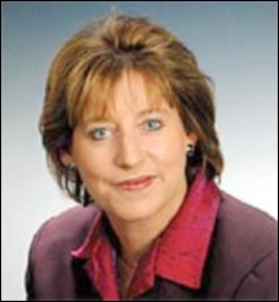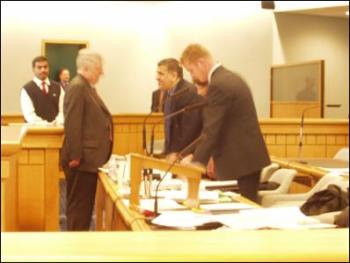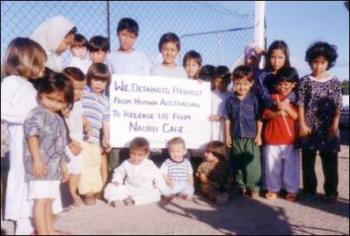An Audience With Lianne Dalziel (Part 2)
See also... Kevin List: An Audience With Lianne Dalziel (I)

Almost every week, there are some new developments in the vexed policy area of immigration. Two major developments related to this portfolio have just occurred. The question of who was to look after detained refugee Ahmed Zaoui and his ‘human rights’ was debated at the Court of Appeal. In the same week the Government announced a $40m cash injection to try and attract more fee-paying foreign students to New Zealand. Former Immigration Minister, Hon Lianne Dalziel, attempted to shed some light on a policy area often clouded by murky political point scoring.
Ahmed Zaoui:

Ahmed Zaoui In The High Court At Auckland
The former Minister supported the Crown’s submission in the recent Court of Appeal case – namely that it should only be the Minister of Immigration that should take a security risk recipient’s human rights into account not the Minister and the Inspector General. Regardless of what happens at the Court of Appeal, Lianne Dalziel has played a major role in the Ahmed Zaoui saga.
“I’ll just use Zaoui as an example. If he’d gone to Australia and there had been no security issues there and no security issues in New Zealand, he wouldn’t be able to bring his wife and children to Australia. He would only get a three year temporary protection visa and have to re-apply at the end of the three years. We would grant the person residence and they would be able to bring their immediate family straight away,” she says.
Mangere Refugee Resettlement Centre:
Although New Zealand received some praise from the United Nation’s High Commissioner for Refugees regional representative, in a report from September 2002, there were also concerns expressed about possible increases in detention relating to asylum seekers.
"What UNHCR specifically like about it is that it is an open facility – people can come and go. Though it’s framed technically as a detention centre, most of it [75%], is for quota refugees [UNHCR approved]. There are a few barracks that have been set aside for the asylum seekers that we can’t identify where they’re from or why they’re here. Those people are able to stay there till such time as we can release them on conditions."
In relation to the use of Auckland Central Remand Prison, the report considered that the remand prison should only be used in exceptional circumstances. The report also stressed that efforts should be made to separate asylum seekers from other inmates, and that the prison psychologist (at the time of the report) could benefit from an ‘exchange’ with the team at Mangere.
When questioned regarding asylum seekers and penal detention, the former Minister painted a rather less rosy picture of life in New Zealand for would-be residents.
"UNHCR requirements are that they (asylum seekers) should not be held with convicted prisoners. They are held in remand prisons. So they are not with convicted criminals."
This desire to uphold the UNHCR guidelines to the letter (albeit not the spirit) may have been behind the decision regarding Zaoui’s placement in solitary at Paremoremo Maximum Security Prison for much of 2003.
"There was one exception [Zaoui]. That was why he couldn’t mix with them [convicted inmates at Paremoremo]."
Question: Given that the current system isn’t entirely satisfactory, had there been any attempt to separate out asylum seekers from the general remand inmates?
"In regard to separating asylum seekers from those awaiting trial on criminal charges, all I can say is that I’m not the Minister anymore and have no influence in that regard."
Dalziel had thought it worth investigating though. "It was something I’ve spoken to two Ministers of Corrections about. Once they go into a corrections facility that is where my jurisdiction ends. Certainly immigration would have made the decision though - usually on security grounds."
New Zealand’s Commitment to International Agreements:

Children from the Tampa, held indefinitely at the Nauru Detention Centre.
Over the last few years New Zealand has looked more and more to uplifting UN Quota refugees (750 per year) from closer to our shores. Although the most recent refugees’ birthplaces may have been Iraq or Afghanistan, New Zealand has been able to fill the bulk of the quota from Indonesia and camps controlled by Australia in the Pacific.
Up until last year the Clark administration had proved more reliable than National at meeting the UN quota, and presumably more fiscally responsible with the trend towards taking refugees from our own backyard. But last year New Zealand missed the quota by rather more than the 10% margin agreed with the UN. The number of UN quota refugees for the financial year 2002-03 was 604 vs the target of 750.
"Last year we were under the 750 because we simply couldn’t send people into Pakistan at that time due to adverse travel warnings near the Afghan border which is where we get most of our refugees."
Somewhat surprisingly given the boom in refugees created by ongoing events in Afghanistan and Iraq, there was no guarantee from the former Minister that we were on track to meet the target this year either.
And despite this lack of queue to jump there was still a predictable outcry from various opposition politicians regarding New Zealand’s acceptance of 20 or so refugees from the Pacific for humanitarian reasons around Christmas 2003.
"On top of the [UN Quota] we have a family reunion category. Refugees can go in a ballot for 300 places. This is one thing I set up when we got rid of the humanitarian category… on top of that is anyone who claims refugee status under the UN Convention. Spontaneous claimants [like Zaoui] are entitled to have their case heard. Quite often I’ve heard Wayne Mapp say we should turn people around at the border. He said we should have sent Zaoui away. Well we can’t actually [do that] under the convention. We have to hear the case and those that are granted refugee status [under 20% claimants] are entitled to bring their immediate family."
However, granting refugee status does not always (as in Zaoui’s case) lead to granting residence. If there are security concerns one can be both a refugee and a non-resident.
Throughout much of the last 25 years refugee numbers have fluctuated. Whilst Minister of Immigration Dalziel did not quite reach the giddy heights of the Muldoon Government [aided by the wars in Indo-China], the numbers under her watch had certainly been steadier than the National-New Zealand First administration. One goal had been to re-assess the current benchmark of 750 once other areas of her portfolio became more manageable.
"I would have like’d to increase the numbers to a 1000 once we got the spontaneous claims under control," she said.



 Eugene Doyle: Writing In The Time Of Genocide
Eugene Doyle: Writing In The Time Of Genocide Gordon Campbell: On Wealth Taxes And Capital Flight
Gordon Campbell: On Wealth Taxes And Capital Flight Ian Powell: Why New Zealand Should Recognise Palestine
Ian Powell: Why New Zealand Should Recognise Palestine Binoy Kampmark: Squabbling Siblings - India, Pakistan And Operation Sindoor
Binoy Kampmark: Squabbling Siblings - India, Pakistan And Operation Sindoor Gordon Campbell: On Budget 2025
Gordon Campbell: On Budget 2025 Keith Rankin: Using Cuba 1962 To Explain Trump's Brinkmanship
Keith Rankin: Using Cuba 1962 To Explain Trump's Brinkmanship